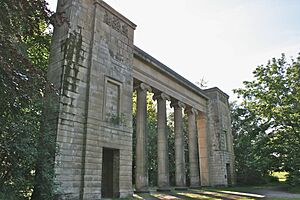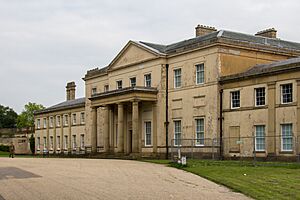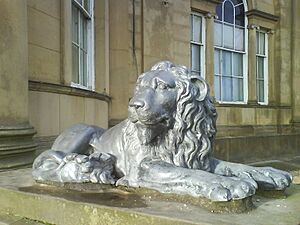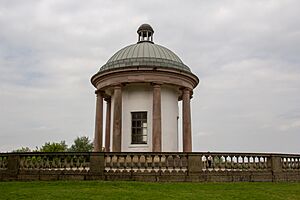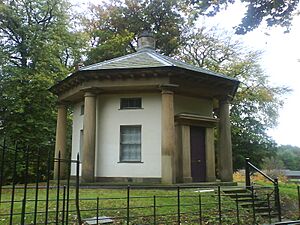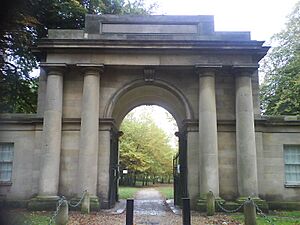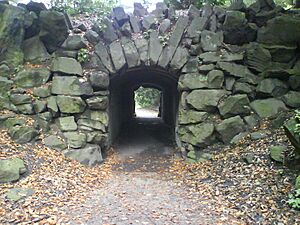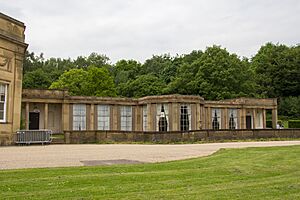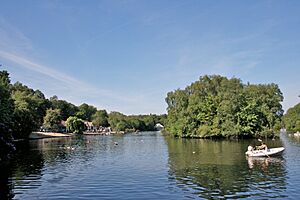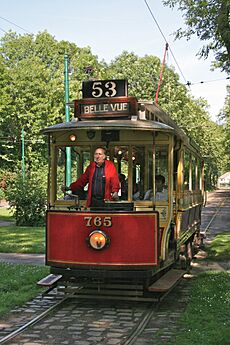Heaton Park facts for kids
Quick facts for kids Heaton Park |
|
|---|---|
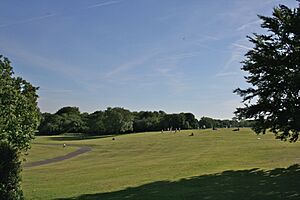
Heaton Park, Manchester
|
|
| Type | Urban Park |
| Location | Prestwich, Bury, England |
| Area | 600–650 acres (240–260 ha) |
| Created | 1902 |
| Operated by | Manchester City Council |
| Status | Open year round |
| Public transit access | Heaton Park Metrolink station |
| Website | Official website: https://www.manchester.gov.uk/heatonpark |
| Official name | Heaton Park |
| Designated | 20 February 1986 |
| Reference no. | 1000854 |
Heaton Park is a huge public park in Prestwich, Bury, England. It covers more than 600 acres (242.8 ha) of land! Inside the park, you'll find Heaton Hall, a beautiful 18th-century country house. This house was designed by a famous architect named James Wyatt in 1772.
Heaton Park is the biggest park in Greater Manchester. It is also one of the largest city parks in all of Europe. The park was bought by Manchester City Council in 1902. It has a special concrete tower called the Heaton Park BT Tower.
The park got a big makeover thanks to a project that cost over £10 million. Today, it has many fun things to do. You can find an 18-hole golf course, a boating lake, and even an animal farm. There are also woodlands, pretty gardens, an adventure playground, and a special monument. A volunteer-run tram system and museum are also part of the park. Heaton Park is a very important historical site, listed as Grade II by Historic England. It even has special bowling greens built for the 2002 Commonwealth Games.
Contents
What's in a Name?
The park gets its name from the nearby area called Great Heaton. The word "Heaton" comes from old English words. "Heah" means 'high' and "tun" means 'enclosure' or 'settlement'. So, it means a 'high settlement'.
Park History
Heaton Hall belonged to the Holland family for a long time. In 1684, it became part of the Egerton family when Sir John Egerton married Elizabeth Holland. In 1772, Sir Thomas Egerton asked the architect James Wyatt to design a new home. Wyatt was only 26, and Heaton Hall was his first big country house project. His amazing house was mostly finished by 1789.
The park's design was created by William Emes. It was used for public events, like the Heaton Park races, which started in 1827. These races later moved to Aintree, where the Grand National is now held.
When the railway was being built to Bury, Lord Wilton didn't want it to spoil his land. So, the train line went under the estate in a tunnel. A railway station opened nearby in 1879, which is now Heaton Park Metrolink station.
Later, Lord Wilton decided to sell the hall and park. People were worried it would be bought by a property developer. So, a group was formed to convince Manchester City Council to buy it. They wanted it to be a museum and a municipal park. The park was bought and opened to the public in 1902.
During the First World War, the park was a training camp for soldiers. Heaton Hall became a military hospital. In the Second World War, the park was a camp for the Royal Air Force, where many aircrew were trained.
Heaton Hall: A Grand House
Heaton Hall is a very important building, listed as Grade I since 1952. It is made of sandstone and brick. The house faces south, looking out over beautiful rolling hills towards the Pennines. A special feature called a ha-ha was used to keep grazing animals away from the formal lawns without blocking the view.
Inside, the hall has grand rooms like the Library, Music Room, and Dining Room. There's also a unique Etruscan Room upstairs. Many talented artists and craftsmen worked on the hall's decorations. The furniture and doors were made by Gillow's of Lancashire. An Italian artist named Biagio Rebecca created many of the decorative paintings. He also designed the case for the 18th-century chamber organ in the Music Room.
Some rooms in the hall are open to the public sometimes. The first-floor rooms include the Cupola, which was once Lady Egerton's dressing room. This room has mirrored walls and a domed ceiling in a special 1770s "Pompeiian" style. There are only three such rooms left in Britain.
Cool Landmarks and Features
The Temple
The ornamental temple was designed by James Wyatt in 1800. It's a simple, round building with columns and a domed roof. This building is Grade II listed and sits on the highest point in Manchester. From here, you can see great views across the golf course. The temple has a fireplace and was probably used as an observatory by the Earl, who owned a telescope. Today, it's used as a summer studio for artists and for astronomy sessions.
The Dower House
The Dower House was a simple brick building that got a fancy new front in 1803. The ha-ha in front of it kept cattle off the lawns without needing a visible fence. Since 2004, this house has been home to the Manchester and District Beekeepers Association. It has an observation hive and displays about bees. There's also an apiary (where bees are kept) in the garden.
Smithy Lodge
This unique "pepperpot" building is at the east entrance of the park. It was designed by Lewis Wyatt in 1806. It has an unusual octagonal shape and was built as a pretty cottage for the lodge keeper. The name comes from a blacksmith's forge that used to be nearby. The lodge was fixed up in the late 1990s and can now be rented for short stays.
Grand Lodge
The Grand Lodge was built in 1807 by Lewis Wyatt. It was designed as a grand main entrance to the park from the south. This lodge is a large triumphal arch made of stone. It has two floors and was once the start of a very long carriage drive to the house. Building this lodge finished the 10-foot (3.0 m) high wall around the park. It was also fixed up and can now be rented. There's a special plaque here remembering the soldiers who trained in the park in 1914.
Western Pleasure Gardens
These beautiful ornamental gardens were likely created in the early 1800s as a quiet place for the family. They have recently been restored to their original design with pools and summerhouses. A tunnel goes from the flower garden to a small valley. This tunnel also has a path above it, allowing cattle to go to the farm for milking without entering the gardens. The tunnel entrance looks like a natural cave.
The Orangery
The orangery was added to the house around 1823. It was probably designed by Lewis Wyatt. It was likely built for Lady Mary Stanley, who loved plants. It had a domed, glass roof and a formal garden. The glass roof was removed after Manchester City Council bought the park in 1902. Today, the orangery is used for events and conferences.
Boating Lake
The 12-acre (4.9 ha) boating lake was built between 1908 and 1912. Unemployed men built it using only shovels and hand-pulled trucks! The lake has three islands and is home to many beautiful birds like geese, ducks, and swans. You can rent rowing boats in the summer. The lake is also popular for fishing, with lots of carp and other fish.
The Colonnade
An interesting structure in the park is the Colonnade. This used to be the front of the old Manchester Town Hall in King Street. When that building was going to be torn down, people fought to save the front. It was then moved and put back together in Heaton Park, at the end of the boating lake.
Walled Garden and Horticultural Centre
The 18th-century Walled Garden was once the Earl of Wilton's kitchen garden. It grew fruits and vegetables for the estate. The walls create a warm space for plants to grow. Today, staff at the Horticultural Centre grow plants for the city and for sale. There are also demonstration gardens and a sensory garden open to the public. The "Friends of Heaton Park" group, which helps care for the park, is based here.
Farm Centre, Stables Cafe, and Animal Centre
The farm centre was originally built as stables for Sir Thomas Egerton. It was designed by Samuel Wyatt and built between 1777 and 1789. Now, it holds the Stables Cafe and the park's offices. The Animal Centre is behind the stables. It was built in 2003–04 and has goats, cattle, pigs, donkeys, alpacas, and other small pets.
Hazlitt Wood Pond
Hazlitt Wood Pond is in Hazlitt Wood, in the far north of the park. You can only reach this quiet and peaceful area by walking.
Past Features
The Runner Statue
A bronze statue of an athlete, called The Runner, was put in the park in 1960. It was made by John Longden. The statue was given to the people of Manchester in 1959. It stayed in the park until it was stolen in October 1968.
Heaton Park Tramway
Soon after Manchester Corporation bought Heaton Park, the tramway was extended into the park. The first tram arrived on May 31, 1903, bringing visitors from Manchester. By 1934, buses were becoming more popular than trams. The tramway was then disconnected from the main system and covered with tarmac for buses to use.
Later, a new plan was made to reopen the old tram line inside the park. This work was finished in 1979, and the Heaton Park Tramway officially opened on March 28, 1980. The line has since been made longer, going through the park to the boating lake. A second tram depot was built there to hold the growing collection of 14 trams.
Heaton Park Golf Course
The park has a championship-level golf course. It was built on what used to be the deer park south of the hall. From the course, you can see views across to the Pennines. Famous golfer John Henry Taylor designed it, and it opened to the public in 1912. It has hosted many professional and amateur golf events. The golf center has its own driving range for teaching. The 11th hole is famous for being very challenging. In 2005, the course was voted the best city golf course in England.
Events in the Park
On May 31, 1982, Pope John Paul II held a special Mass in the park for over 100,000 people. He also made 12 new priests. A monument in the park remembers this important event.
Music Events
In 1909, a famous singer named Enrico Caruso performed in Manchester. A few days later, a salesman named William Grimshaw played recordings of Caruso's songs in Heaton Park. About 40,000 people came to listen! Caruso later thanked Mr. Grimshaw for playing his music so well. Grimshaw was the first person in Britain to give open-air gramophone concerts.
Since the 1980s, many outdoor rock concerts have been held in the park. Bands like Travis and Supergrass have played there. The BBC's "Proms in the Park" has also been held here many times.
The Manchester band, Oasis, played for 210,000 people over three nights in June 2009. In June 2012, another Manchester band, The Stone Roses, played three sold-out shows at Heaton Park. Since February 2013, Manchester's yearly Parklife Weekender music festival has been held at Heaton Park.
Manchester band Courteeners played their biggest show ever at the park on June 5, 2015.
On July 1, 2016, the park hosted a concert and exhibition. This was part of the national event to remember 100 years since the Battle of the Somme. People could make special tiles, which were laid as a path through the park. An evening concert featured a children's choir, old films, dance, and Manchester's Hallé Orchestra.
On November 27, 2019, Liam Gallagher announced a show for June 12, 2020. Tickets sold out in just 3 hours! However, the concert was canceled because of the COVID-19 pandemic.
Oasis Live '25 Reunion Tour
On August 27, 2024, Oasis announced they were getting back together for a tour. Heaton Park was chosen as the place for five concerts between July 11 and July 20, 2025.
Gallagher Hill
Even though a large fence was put up, thousands of fans without tickets gathered on a south-facing hill in the park. This spot was quickly nicknamed "Gallagher Hill." From there, they watched Oasis on giant screens.
On July 19, 2025, Liam Gallagher dedicated a song to the fans on the hill. Noel Gallagher even arranged for a live video of their celebrations to be shown on the main stage screens. He also paid for 1,000 special T-shirts to be given out on the hill.
After the last concert, Manchester City Council and many volunteers cleaned up the park. They also replanted grass in worn areas, making sure Gallagher Hill was ready for everyone to enjoy again.
Theatre Productions
In recent years, the park has hosted outdoor theatre shows. Since 1998, Feelgood Theatre Productions has performed plays like The Wizard of Oz and The Wind in the Willows. They also performed Shakespeare's A Midsummer Night's Dream and Macbeth. In 2016, Feelgood returned with new shows like Whispers of Heaton. Feelgood is now the official theatre partner for Heaton Park.
The Shakespeare's Globe Theatre also performs outdoor plays every year. They performed Shakespeare's works in 2008, 2009, and A Midsummer Night's Dream in June 2010.
Sports and Culture
A 5 km (3.1 mi) run is organized by Parkrun every Saturday morning.
The park often hosts charity running events like 'Race for Life'. Seasonal fairs are also held near the Papal monument. Every year on November 5 (Guy Fawkes Night), there is a large bonfire and firework display.
See also
- Grade I listed buildings in Greater Manchester
- Grade II* listed buildings in Greater Manchester
- Listed buildings in Manchester-M25 (Manchester district)
Images for kids



